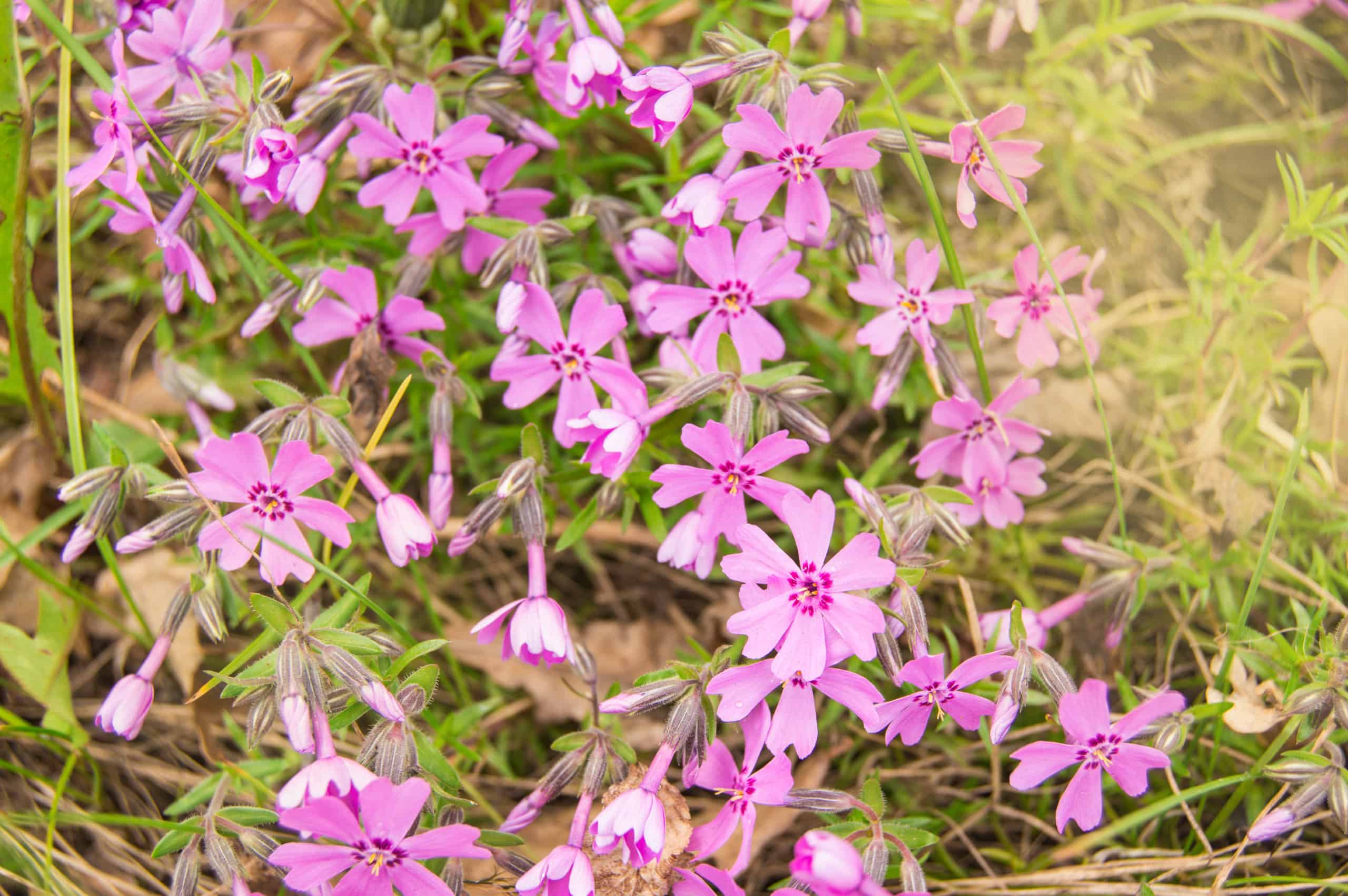Flowering pink perennial flowers look like a painting coming to life. From sunrise to sunset, the light dances off each colorful bloom.
Whether you’re looking to see woodland wildflowers in their natural habitat or want to plan your own garden, this article is for you. We’ll reveal some of the best pink perennials, how to identify them, and where they exist. We’ll also explore the top gardening tips so you can add these flowers to your yard!
Read on to learn about five pink perennials.
1. Creeping Phlox
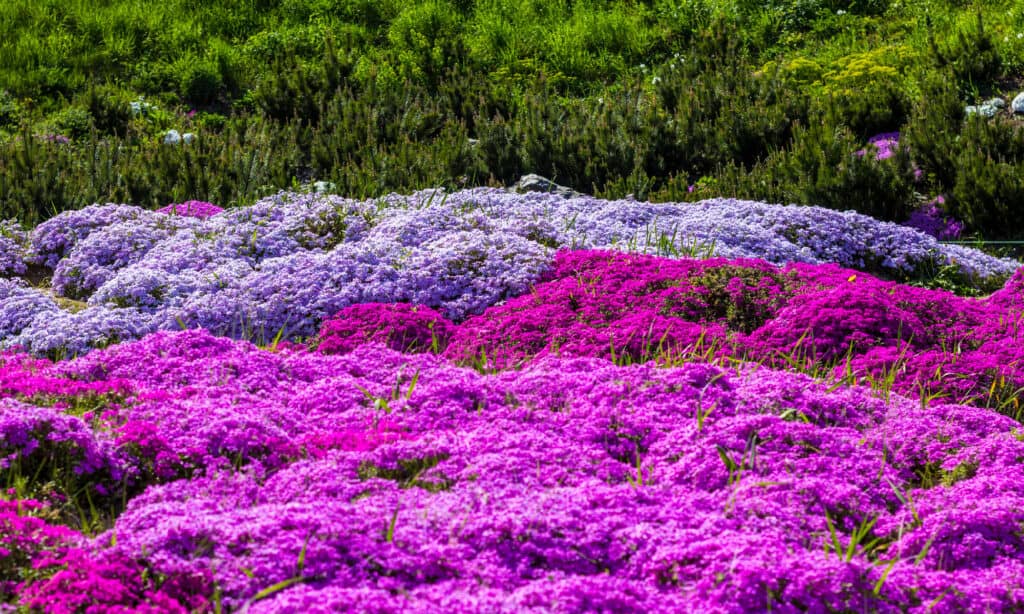
Creeping phlox ground cover is often used in landscaping when creating alpine slides and rockeries.
©iStock.com/MaYcaL
Are you looking for a native phlox that you can grow in your garden? Then look no further than the creeping phlox perennial. This gorgeous plant produces fine blooms for a long period of time. They belong to the same family as forget-me-nots.
The branches of phlox plants spread and reach out to touch the ground. As the branches spread, they produce new roots at each spot and continue to grow.
Identification Clues
The petals have a lovely pink and white-blue color. Each flower has five petals and a long tube. You’ll notice there are a lot of other phloxes available for you with similar blossoms. If you like the creeping phlox, you should check out the blue phlox and the Sweet William phlox.
Natural Habitat
The majority of the creeping phlox varieties thrive in moist woods by lakes and bottomland environments. They’re prevalent throughout Pennsylvania to Ohio and occur in Southern California and Georgia.
Gardening Tips
Creeping phlox grow to be 6 to 12 inches tall and blooms between April and June. For the best garden, you’ll want to plant these pink perennial flowers in partial shade with rich organic soil.
They only need average soil moisture to grow expediently. They’ll spread rapidly, and several plants can create a gorgeous groundcover within a year. This perennial readily self-seeds as well.
2. Trilliums
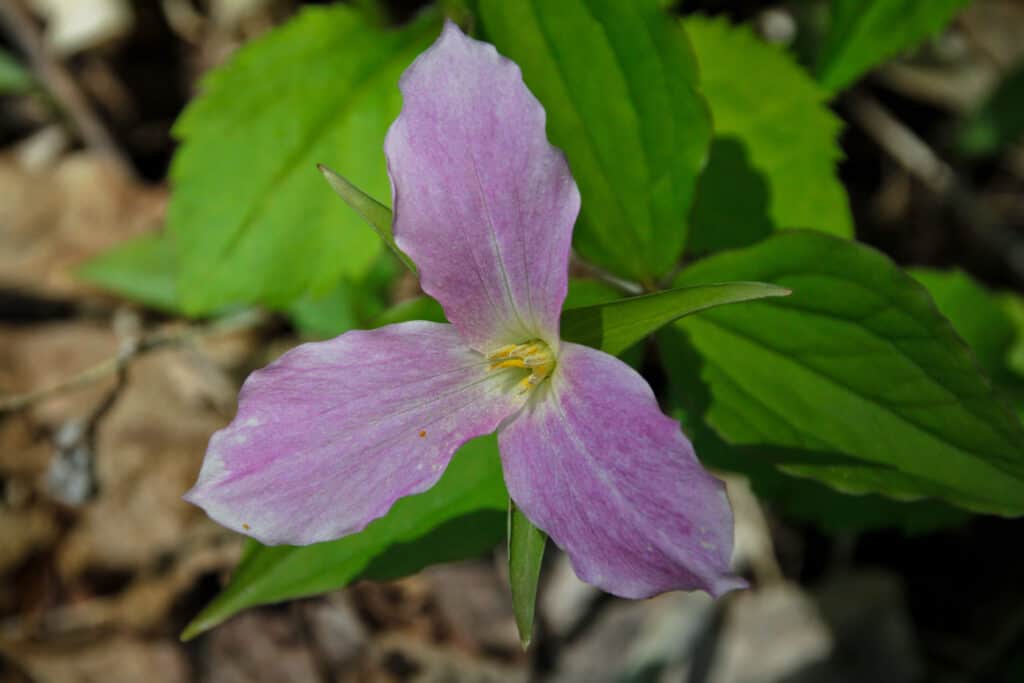
A pink White Trillium in Ontario, Canada forest. White trilliums turn pink as they age.
©iStock.com/Zoe Weber
The trillium plant is a native North American wildflower with three large leaves and a single three-petaled blossom. The blooms can be white, pink, or red, and they appear in early spring.
This flower comes from the Latin word “triplex,” which means “threefold.” It is sometimes called the wake robin, stinking Benjamin, or birthroot.
Identification Clues
The trillium has three large, oval-shaped leaves that grow from a single point at the top of the stem. The stem is usually about 6 inches tall, and the leaves are 2-6 inches long. The flowers have three petals that are each 2-3 inches long.
Natural Habitat
Trilliums thrive in woods in the eastern half of North America, from Nova Scotia to Georgia and west to Minnesota. They prefer shady, moist conditions with rich soil.
Gardening Tips
Ants play a unique role in the dispersal of wild trillium seeds. But it can be tricky getting trillium seeds in an ethical way to add them to your garden. If you dig them up in the wild, removing them could cause too much shock to the plant.
If your garden doesn’t have the right needs for these plants, they will surely die quickly. Instead, it’s best to find trillium seeds from a nursery that propagates them on-site. Trilliums can be difficult to grow from seed, but they can easily propagate from rhizomes (underground stems). Rhizome cuttings can come from plants in early summer.
3. Lady slippers
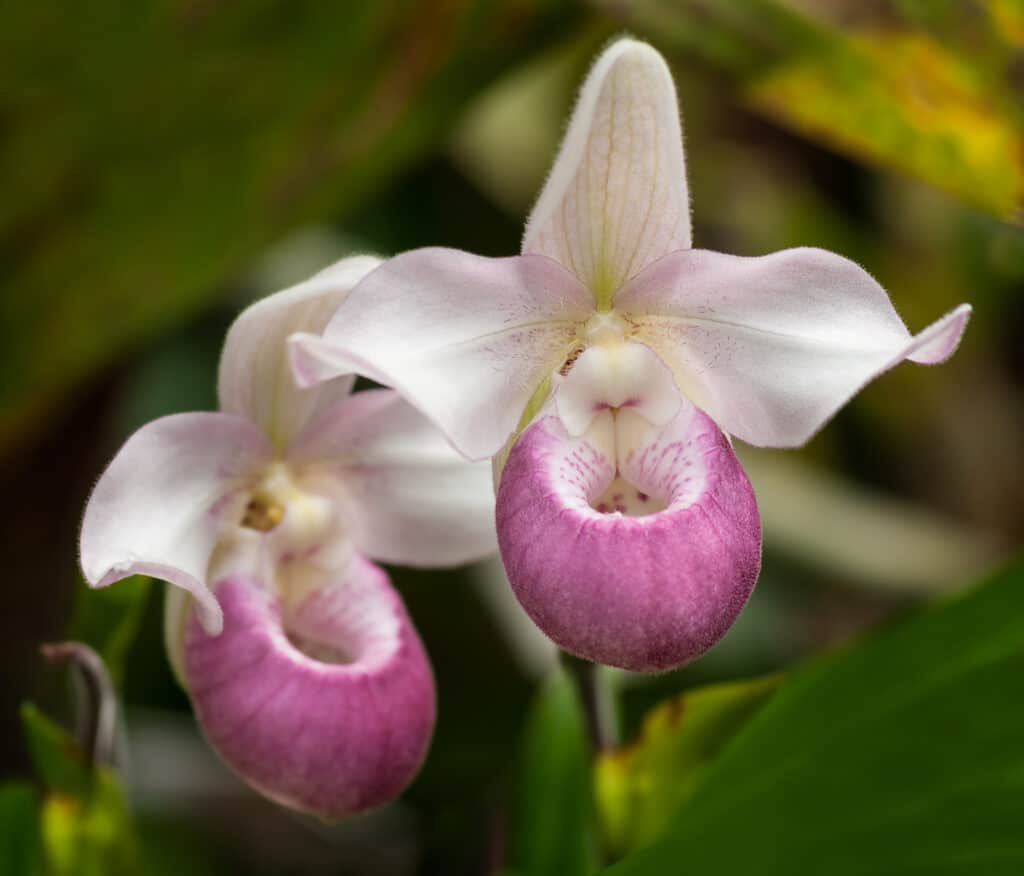
The lip of a lady’s slipper flower looks like a dainty slipper.
©iStock.com/hkuchera
Are you looking for pink perennial flowers that look stunning in the wild? Check out lady slippers. Looking for these plants in their natural habitat can be a fascinating experience.
Lady slippers are a type of orchid, so their seeds don’t develop like other plants. Instead, the lady slippers shed thousands of seeds every fall, and each seat is smaller than a speck of dust.
Identification Clues
To enjoy pink blooms, you’ll need to look for pink lady slippers or showy lady slippers. The pink variation has a leafless flower stem.
Both lady slippers have a large, colorful pouch that resembles a fancy shoe. The petals and sepals (the parts of the flower that usually look like leaves) are often pink or purple. The plants can grow to be 1-2 feet tall.
Natural Habitat
Lady slippers are found in woods, swamps, and bogs in the northern United States and Canada. They prefer shady, moist conditions with acidic soil.
Gardening Tips
You can grow lady slippers from seed, but it is a slow process. It can take 5-10 years for the plants to bloom. Lady slippers can also be propagated from root cuttings taken in early summer.
4. Queen of the Prairie
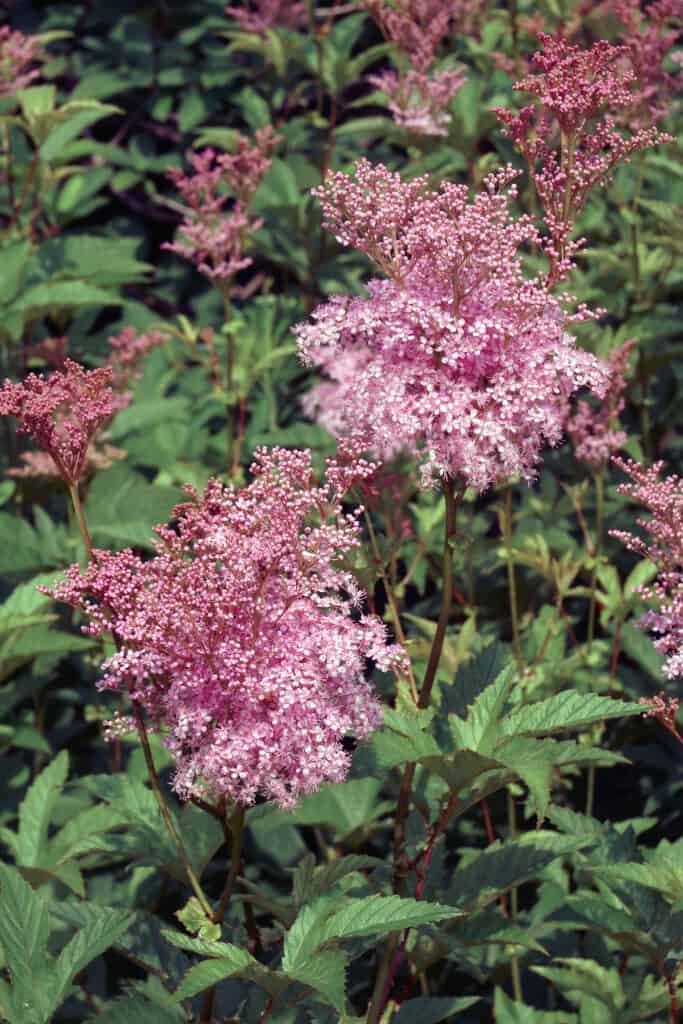
The roots of the queen of the prairie plant (
Filipendula rubra)have tannins that some use for medicinal purposes.
©iStock.com/nickkurzenko
Enjoy a breathtaking perennial, the queen of the prairie. Queen of the prairie earns its name with elegant blooms and regal stature. Native Americans used this plant to help those suffering from heart problems. The blossoms are lovely, and they smell great too! After taking in the beautiful fragrance, you can’t help but feel better.
Identification Clues
The queen of the prairie has long, slender leaves that grow from 2-4 feet on tall stems. Under the right conditions, the plant can reach a height of up to 6 feet.
Natural Habitat
You’ll find a lot of queen of the prairie perennials flourishing from Iowa to Western Pennsylvania. They do well in meadows and prairies with moist soil.
Gardening Tips
Ideally, you’ll want to find a place in your garden with full sun and average to moist soil conditions. This plant grows best in cooler climates but can be found as far south as North Carolina. These royal pink perennials bloom between June and August.
5. Bleeding Heart
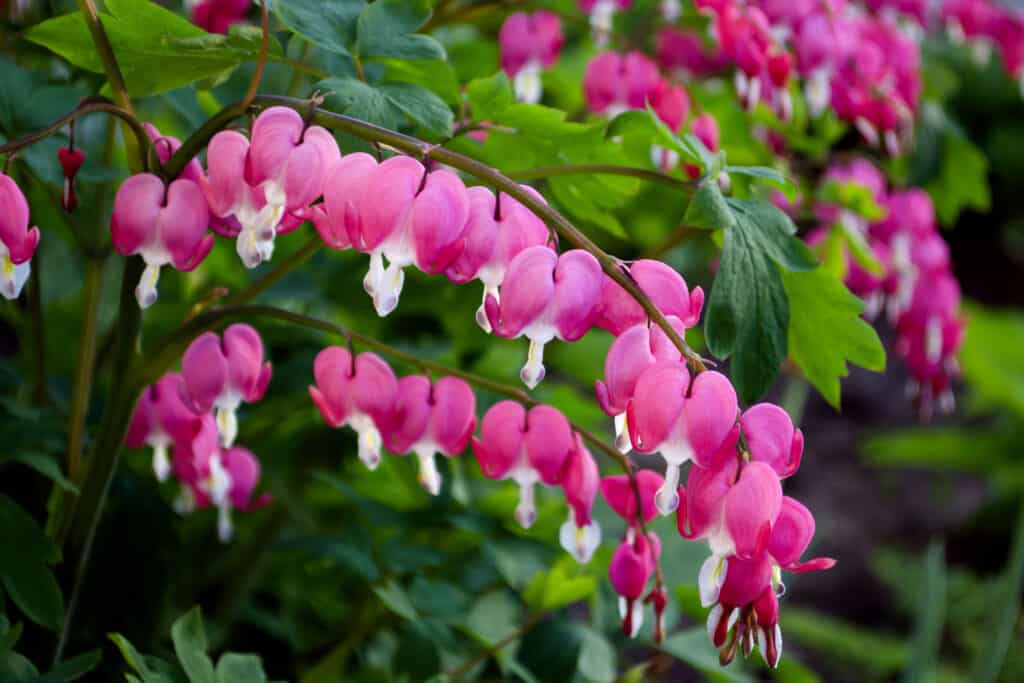
Bleeding heart plants are native to
Japan
,
Korea
, northern
China
, and
Siberia
, although they are used in gardens around the world.
©iStock.com/Oksana Akhtanina
Pick a bleeding heart flower and carefully pull it apart. The pieces create a unique image. The flower petals will either resemble a pair of pink rabbits, two tall glasses, a harp, or a wine bottle. It’s one of the many unique features of these pink perennial flowers. While pink, parts of the flower are crimson red and white.
Identification Clues
Bleeding heart perennials have finely cut leaves and flowers that resemble small hearts. The small pink or red heart suspends at the tip of each flower’s stock.
Sometimes these plants have more of a pink hue than they do a red hue. The exact coloration will depend on the seeds you use.
Natural Habitat
You can find bleeding heart perennials throughout the rocky woods and the Appalachian Mountains. They’re also prevalent throughout New York.
Gardening Tips
The bleeding heart blooms throughout the entire summer and is shade tolerant. This perennial has gorgeous spoilage and only needs average moisture in the soil. It can tolerate cool climates, but you won’t get as luxurious foliage. These plants increase the sizes of the clump and can be divided during the spring or fall.
Up Next:
Thank you for reading! Have some feedback for us? Contact the AZ Animals editorial team.

